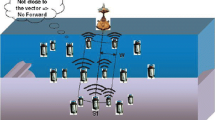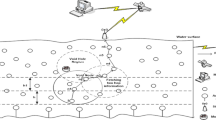Abstract
Three major problems of wireless sensor networks can be summarized into communication traffic, energy consumption and routing security. In this paper, we analyze performance of an underwater sensor network in dense mode under creation of spherical division-based forbidden regions. Obviously, unnecessary smart node removal from the packet forwarding process of a flooding-based routing policy is theoretically an idea for enhancing the known network parameters. In this research, our purposed approach is to improve energy consumption by using a removal process over physical routing space toward more network reliability and better network lifetime. Clearly, our aim is performance improvement in terms of a network protocol in an underwater wireless sensor networks with a huge number of high-speed mobile nodes. The nodes generally consist of different underwater instruments such as sensors, robots, modems and batteries and are categorized into two groups of autonomous unmanned underwater vehicles and remotely operated vehicles. The proposed approach is a hybrid solution based on vector-based forwarding routing protocol and spherical divisions which is named spherical division-based vector-based forwarding. The proposed protocol can successfully reduce energy consumption and equivalently increase the network lifetime while packet delivery ratio is in a saturation level. In details, our proposed method works on preservation of sensors’ energy in which we physically remove some additional paths of routing process (based on a multipath forwarding using a basic routing algorithm). In this regard, we apply a spherical division-based physical restriction on the routing space. However, removing these additional sensor nodes/routers is conditionally done under keeping the suitable traffic performance in terms of PDR because it is essential to say that a new scheme is effective.











Similar content being viewed by others
References
Ayaz M, Baig I, Abdullah A, Faye I (2011) A survey on routing techniques in underwater wireless sensor networks. J Netw Comput Appl 34:1908–1927
Waseem MH, Alamzeb M, Mustafa B (2013) Design of a low-cost underwater wireless sensor network for water quality monitoring. IETE J Res 59(5):523–534
Khosravi MR, Basri H, Khosravi A, Rostami H (2015) Energy efficient spherical divisions for VBF-based routing in dense UWSNs. In: Proceedings of KBEI 2015, IUST, Tehran, Iran, pp 961–965
Amalia C, Jayaprakasha D, Ramachandrana B (2014) Enhanced media independent network selection for heterogeneous wireless networks. IETE Tech Rev 31(5):392–401
Rajkumara S, Goyala NK (2015) Fault tolerant interconnection network design. IETE Tech Rev 33:396–404
Prasad P (2015) Recent trend in wireless sensor network and its applications: a survey. Sens Rev 35(2):229–236
Xie P, Cui J, Lao L (2006) VBF: vector-based forwarding protocol for underwater sensor networks. In: Proceedings of International IFIP Conference: Networking Technologies, Services and Protocols Performance of Computer and Communication Networks, Mobile and Wireless Communications Systems, pp 1216–1221
Xie P et al (2010) Efficient vector-based forwarding for underwater sensor networks. EURASIP J Wirel Commun Netw 2010:195910. doi:10.1155/2010/195910
Yu H, Yao N, Liu J (2014) An adaptive routing protocol in underwater sparse acoustic sensor networks. Ad Hoc Netw 34:121–143
Ibrahim DM et al (2014) Enhancing the vector-based forwarding routing protocol for underwater wireless sensor networks: a clustering approach. In: Proceedings of the Tenth International Conference on Wireless and Mobile Communications, pp 98–104
Khosravi MR, Basri H, Rostami H (2015) Improvement of energy consumption in dense underwater sensor networks. In: Proceedings of 2nd International Congress of Electrical Engineering, Computer Science and Information Technology (IT2015), SBU, Tehran, Iran, vol 9, pp 1–9
Cai S, Gao Z, Yang D, Yao N (2013) A network coding based protocol for reliable data transfer in underwater acoustic sensor. Ad Hoc Netw 11:1603–1609
Pouryazdanpanah M, Anjomshoa M, Salehi A, Afroozeh A, Moshfegh M (2014) DS-VBF: dual sink vector-based routing protocol for underwater wireless sensor network. In: Proceedings of 5th Control and System Graduate Research Colloquium, Malaysia
Proakis JG, Rice JA, Sozer EM, Stojanovic M (2001) Shallow water acoustic networks. IEEE Commun Mag 39(11):114–119
Razaquea A, Elleithya K (2016) Nomenclature of medium access control protocol over wireless sensor networks. IETE Tech Rev 33(2):160–171
Niculescu D, Nath B (2003) Trajectory based forwarding and its applications. In: Proceedings of the 9th Annual International Conference on Mobile Computing and Networking (MOBICOM’03), San Diego, USA
Islam M, Kim J (2012) Step-by-step approach for energy-efficient wireless sensor network. IETE Tech Rev 29:336–345
Jornet M, Stojanovic M, Zorzi M (2008) Focused beam routing protocol for underwater acoustic networks. In: Proceedings of the ACM WUWNet, San Francisco, CA, USA, pp 75–81
Daeyoup H, Dongkyun K (2008) DFR: directional? Flooding-based routing protocol for underwater sensor networks. In: Proceedings of the OCEANS, Quebec City, QC, Canada
Nicolaouy N, See A, Xie P, Cui J, Maggiorini D (2007) Improving the robustness of location-based routing for underwater sensor networks, IEEE
Yan H, Shi Z, Cui J (2008) DBR: depth-based routing for underwater sensor networks. In: Proceedings of the 7th International IFIP-TC6 Networking Conference on Ad-hoc and Sensor Networks
Uichin L et al (2010) Pressure routing for underwater sensor networks. In: Proceedings of the IEEE Conference: INFOCOM, San Diego, CA
Ayaz M, Abdullah A (2009) Hop-by-hop dynamic addressing based (H2-DAB) routing protocol for underwater wireless sensor networks. In: Proceedings of the International Conference on Information and Multimedia Technology (ICIMT’09), Republic of Korea, pp 436–441
Ayaz M, Abdullah A, Faye I (2010) Hop-by-hop reliable data deliveries for underwater wireless sensor networks. In: Proceedings of the 5th International Conference on Broadband Wireless Computing, Communication and Applications (BWCCA’10), Fukuoka, Japan, pp 363–368
Gopi S, Govindan K, Chander D, Desai UB, Merchant SN (2010) E-PULRP: energy optimized path unaware layered routing protocol for underwater sensor networks. IEEE Trans Wirel Commun 9(11):3391–3401
Chen GM, Wu XB, Chen GH (2008) REBAR: a reliable and energy balanced routing algorithm for UWSNs. In: Proceedings of the seventh International Conference on Grid and Cooperative Computing, Shenzhen, China, pp 349–355
Domingo MC (2011) A distributed energy-aware routing protocol for underwater wireless sensor networks. Wirel Pers Commun 51(4):607–627
Pu W, Cheng L, Jun Z (2007) Distributed minimum-cost clustering protocol for under- water sensor networks (UWSNs). In: Proceedings of the IEEE International Conference on Communications, Glasgow, Scotland, United Kingdom, pp 3510–3515
Anupama KR, Sasidharan A, Vadlamani S (2008) A location-based clustering algorithm for data gathering in 3D underwater wireless sensor networks. In: Proceedings of the International Symposium on Telecommunications (IST), Tehran, Iran, pp 343–348
Wang C, Liu GL (2011) LUM-HEED: a location unaware, multi-hop routing protocol for underwater acoustic sensor networks. In: Proceedings of 2011 International Conference on Computer Science and Network Technology, China, pp 2236–2240
Liu GZ, Wei CY (2011) A new multi-path routing protocol based on cluster for underwater acoustic sensor networks. In: Proceedings of 2011 International Conference on Multimedia Technology, China, pp 91–94
Younis Abbasi, M (2007) A survey on clustering algorithms for wireless sensor networks. Comput Commun 30:2826–2841
Zhou Z, Cui JH, Shi ZJ (2011) Efficient multipath communication for time-critical applications in underwater acoustic sensor networks. IEEE Trans Netw 19:28–41
Dhurandher SK, Obaidat MS, Gupta M (2013) Energized geocasting model for underwater wireless sensor networks. Simul Model Pract Theory 37:125–138
Hao K, Jin Z, Shen H, Wang Y (2015) An efficient and reliable geographic routing protocol based on partial network coding for underwater sensor networks. Sensors 15:12720–12735
Sharif-Yazd M, Khosravi MR, Moghimi MK (2017) A survey on underwater acoustic sensor networks: perspectives on protocol design for signaling, MAC and routing. J Comput Commun 5:12–23
Xie P et al (2009) Aqua-Sim: an NS-2 based simulator for underwater sensor networks. In: Proceedings of the OCEANS2009, MTS/IEEE Biloxi Marine Technology for Our Future: Global and Local Challenges
Pompili D, Melodia T (2005) Three-dimensional routing in underwater acoustic sensor networks. In: Proceedings of the 2nd ACM International Workshop on Performance Evaluation of Wireless Ad-hoc, Sensor, and Ubiquitous Networks (WASUN’05), Montreal, Calif, USA, pp 214–221
Khosravi MR, Basri H, Rostami H (2015) Routing with using vector-based forwarding in underwater wireless sensor networks. In: Proceedings of 2nd International Congress of Electrical Engineering, Computer Science and Information Technology (IT2015), SBU, Tehran, Iran, vol 9, pp 10–20
Ali T, Jung LT, Ameer S (2012) Flooding control by using angle based cone for UWSNS. In: Proceedings of 1st IEEE International Telecommunication Technologies, Kuala Lumpur, Malaysia, pp 112–117
Kuila P, Jana PK (2014) Approximation schemes for load balanced clustering in wireless sensor networks. J Supercomput 68:87–105
Torabi AT, Er MJ, Li X, Lim BS (2016) Sequential fuzzy clustering based dynamic fuzzy neural network for fault diagnosis and prognosis. Neurocomputing 196:31–41
Alhihi M (2017) Practical routing protocol models to improve network performance and adequacy. J Comput Commun 5:116
Acknowledgements
The authors would like to thank the managing editor and also all reviewers for their reviews and helpful comments.
Author information
Authors and Affiliations
Corresponding author
Rights and permissions
About this article
Cite this article
Khosravi, M.R., Basri, H. & Rostami, H. Efficient routing for dense UWSNs with high-speed mobile nodes using spherical divisions. J Supercomput 74, 696–716 (2018). https://doi.org/10.1007/s11227-017-2148-x
Published:
Issue Date:
DOI: https://doi.org/10.1007/s11227-017-2148-x




